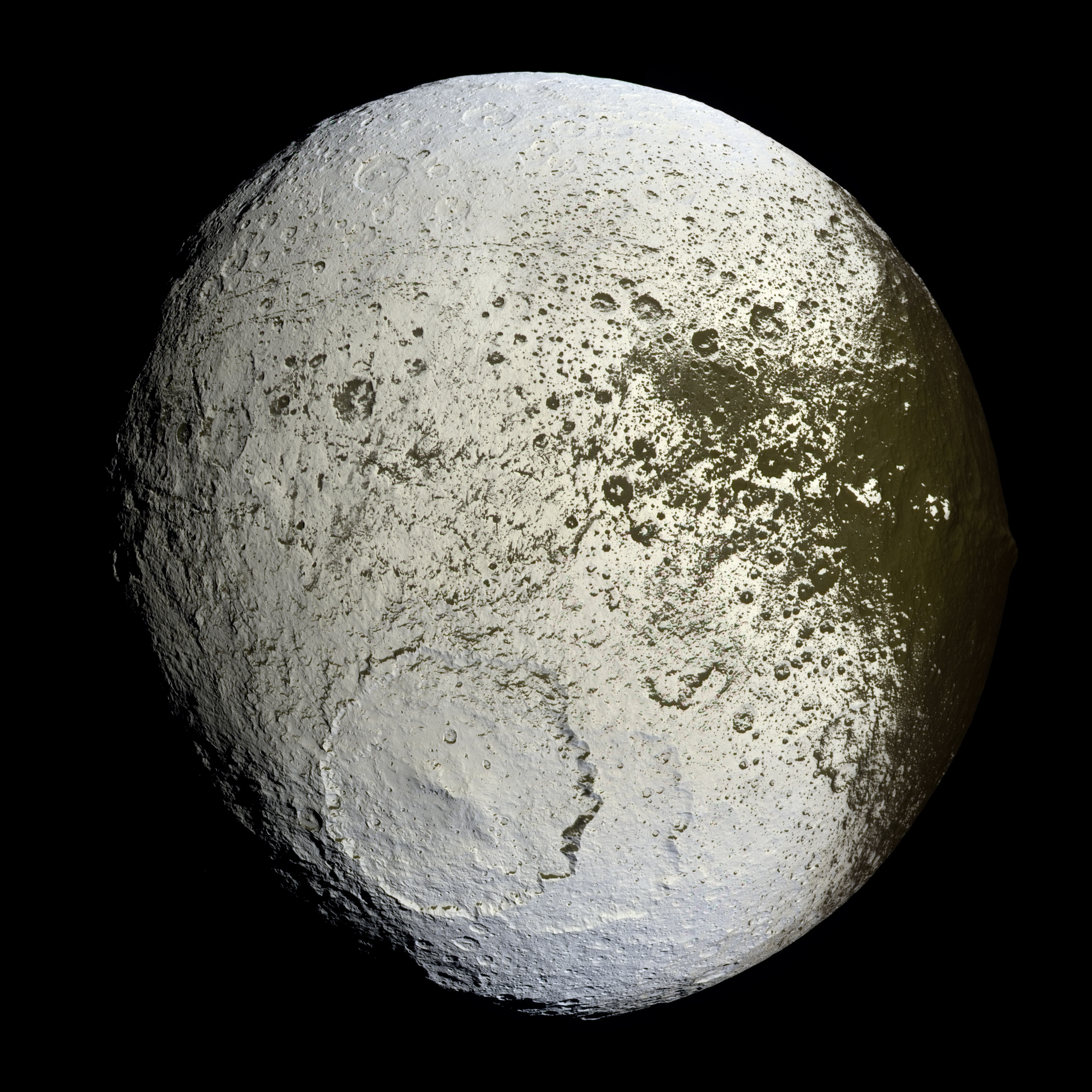|
List Of Geological Features On Iapetus
Most Iapetian geological features are named after characters and locations in the Old French epic poem '' The Song of Roland'', specifically the English translation by Dorothy L. Sayers. Gazetteer of Planetary Nomenclature Montes A ''mons'' , pl. ''montes'' , is a mountain.Regiones There is one named Iapetian ''regio'' (area of distinct albedo difference), Cassini:Terrae There are two named Iapetian ''terrae'' (large 'land' masses). The adjectival form of ''Roncevaux'' is ''Roncesvallian''.Craters Named impact craters are:References * Mackey & Mackey, ...[...More Info...] [...Related Items...] OR: [Wikipedia] [Google] [Baidu] |
Iapetus (moon)
Iapetus () is a moon of Saturn. It is the 24th of Saturn’s 83 known moons. With an estimated diameter of 1,469 km, it is the third-largest moon of Saturn and the eleventh-largest in the Solar System. Named after the Titan Iapetus, the moon was discovered in 1671 by Giovanni Domenico Cassini. A relatively low-density body made up mostly of ice, Iapetus is home to several distinctive and unusual features, such as a striking difference in coloration between its leading hemisphere, which is dark, and its trailing hemisphere, which is bright, as well as a massive equatorial ridge running three-quarters of the way around the moon. History Discovery Iapetus was discovered by Giovanni Domenico Cassini, an Italian-born French astronomer, in October 1671. He had discovered it on the western side of Saturn and tried viewing it on the eastern side some months later, but was unsuccessful. This was also the case the following year, when he was again able to observe it on the weste ... [...More Info...] [...Related Items...] OR: [Wikipedia] [Google] [Baidu] |
Abisme (crater)
Abisme /æˈbiːm/ is a large impact basin located in Cassini Regio at 37.5°N, 267.1°E. Craters Climborin, Clarin, Dapamort, Johun and Valdebron can be found inside Abisme. It was imaged for the first time by the Cassini spacecraft in 2004. Nomenclature Abisme is named after a Saracen baron in the Old French epic poem Song of Roland;this name was approved by the International Astronomical Union (IAU) on 16 August 2013. See also * List of geological features on Iapetus Most Iapetian geological features are named after characters and locations in the Old French epic poem ''The Song of Roland'', specifically the English translation by Dorothy L. Sayers. References [...More Info...] [...Related Items...] OR: [Wikipedia] [Google] [Baidu] |
Impact Crater
An impact crater is a circular depression in the surface of a solid astronomical object formed by the hypervelocity impact of a smaller object. In contrast to volcanic craters, which result from explosion or internal collapse, impact craters typically have raised rims and floors that are lower in elevation than the surrounding terrain. Lunar impact craters range from microscopic craters on lunar rocks returned by the Apollo Program and small, simple, bowl-shaped depressions in the lunar regolith to large, complex, multi-ringed impact basins. Meteor Crater is a well-known example of a small impact crater on Earth. Impact craters are the dominant geographic features on many solid Solar System objects including the Moon, Mercury, Callisto, Ganymede and most small moons and asteroids. On other planets and moons that experience more active surface geological processes, such as Earth, Venus, Europa, Io and Titan, visible impact craters are less common because they become ... [...More Info...] [...Related Items...] OR: [Wikipedia] [Google] [Baidu] |
Zaragoza
Zaragoza, also known in English as Saragossa,''Encyclopædia Britannica'"Zaragoza (conventional Saragossa)" is the capital city of the Zaragoza Province and of the autonomous community of Aragon, Spain. It lies by the Ebro river and its tributaries, the Huerva and the Gállego, roughly in the center of both Aragon and the Ebro basin. On 1 January 2021 the population of the municipality of Zaragoza was 675,301, (the fifth most populated in Spain) on a land area of . The population of the metropolitan area was estimated in 2006 at 783,763 inhabitants. The municipality is home to more than 50 percent of the Aragonese population. The city lies at an elevation of about above sea level. Zaragoza hosted Expo 2008 in the summer of 2008, a world's fair on water and sustainable development. It was also a candidate for the European Capital of Culture in 2012. The city is famous for its folklore, local cuisine, and landmarks such as the Basílica del Pilar, La Seo Cathedral an ... [...More Info...] [...Related Items...] OR: [Wikipedia] [Google] [Baidu] |
Saragossa Terra
Saragossa Terra is the name given to the southern part of the highly reflective half of Saturn's moon Iapetus. It is bordered on the north by Roncevaux Terra, and on both the east and west sides by Cassini Regio. The largest named crater in Saragossa Terra is the 504-km-diameter Engelier. It partially obscures the slightly smaller crater Gerin. Both craters are named for paladins mentioned in The Song of Roland ''The Song of Roland'' (french: La Chanson de Roland) is an 11th-century '' chanson de geste'' based on the Frankish military leader Roland at the Battle of Roncevaux Pass in 778 AD, during the reign of the Carolingian king Charlemagne. It i .... References Surface features of Iapetus (moon) {{crater-stub ... [...More Info...] [...Related Items...] OR: [Wikipedia] [Google] [Baidu] |
Battle Of Roncevaux Pass
The Battle of Roncevaux Pass (French and English spelling, '' Roncesvalles'' in Spanish, ''Orreaga'' in Basque) in 778 saw a large force of Basques ambush a part of Charlemagne's army in Roncevaux Pass, a high mountain pass in the Pyrenees on the present border between France and Spain, after his invasion of the Iberian Peninsula. The Basque attack was a retaliation for Charlemagne's destruction of the city walls of their capital, Pamplona. As the Franks retreated across the Pyrenees back to Francia, the rearguard of Frankish lords was cut off, stood its ground, and was wiped out. Among those killed in the battle was Roland, a Frankish commander. His death elevated him and the paladins, the foremost warriors of Charlemagne's court, into legend, becoming the quintessential role model for knights and also greatly influencing the code of chivalry in the Middle Ages. There are numerous written works about the battle, some of which change and exaggerate events. The battle is ... [...More Info...] [...Related Items...] OR: [Wikipedia] [Google] [Baidu] |
Roncevaux Terra
Roncevaux Terra is the name given to the northern part of the highly reflective side of Saturn's moon Iapetus. The southern half of this side is named ''Saragossa Terra''. The other half of Iapetus, named Cassini Regio, is extremely dark. It is believed that Roncevaux Terra's colour is the underlying colour of Iapetus, while Cassini Regio was formed either by a substance that has covered up the brighter ice of the rest of the moon, or by a residue left from the sublimation of Roncevaux-type water ice. Roncevaux Terra is named after the Battle of Roncevaux Pass, subject of the French epic poem the ''Chanson de Roland ''The Song of Roland'' (french: La Chanson de Roland) is an 11th-century '' chanson de geste'' based on the Frankish military leader Roland at the Battle of Roncevaux Pass in 778 AD, during the reign of the Carolingian king Charlemagne. It i ...'', after whose characters the surface features of Iapetus are named. Notes References External links * Map of I ... [...More Info...] [...Related Items...] OR: [Wikipedia] [Google] [Baidu] |
Giovanni Domenico Cassini
Giovanni Domenico Cassini, also known as Jean-Dominique Cassini (8 June 1625 – 14 September 1712) was an Italian (naturalised French) mathematician, astronomer and engineer. Cassini was born in Perinaldo, near Imperia, at that time in the County of Nice, part of the Savoyard state. Cassini is known for his work on astronomy and engineering. He discovered four satellites of the planet Saturn and noted the division of the rings of Saturn; the Cassini Division was named after him. Giovanni Domenico Cassini was also the first of his family to begin work on the project of creating a topographic map of France. The ''Cassini'' space probe, launched in 1997, was named after him and became the fourth to visit the planet Saturn and the first to orbit the planet. Life Time in Italy Cassini was the son of Jacopo Cassini, a Tuscan, and Giulia Crovesi. In 1648 Cassini accepted a position at the observatory at Panzano, near Bologna, to work with Marquis Cornelio Malvasia, a rich amate ... [...More Info...] [...Related Items...] OR: [Wikipedia] [Google] [Baidu] |
Cassini Regio
Cassini Regio (adjective ''Cassinian'' ) is the enigmatic dark area that covers the leading half of Saturn's moon Iapetus. It is named after Giovanni Cassini, the discoverer of Iapetus; ' Regio' is a term used in planetary geology for a large area that is strongly differentiated in colour or albedo from its surroundings. The brighter half of Iapetus is composed of the Roncevaux Terra and the Saragossa Terra. The nature of the material that caused the extensive discoloration of Cassini Regio is not known, but it appears to be quite thin. It may be the result of cryovolcanism, a spattering of material from outer moons, or residue left by the sublimation of brighter ice. In December 2004 an image taken by the NASA The National Aeronautics and Space Administration (NASA ) is an independent agency of the US federal government responsible for the civil space program, aeronautics research, and space research. NASA was established in 1958, succeedi ... ''Cassini'' pr ... [...More Info...] [...Related Items...] OR: [Wikipedia] [Google] [Baidu] |
.jpg)


